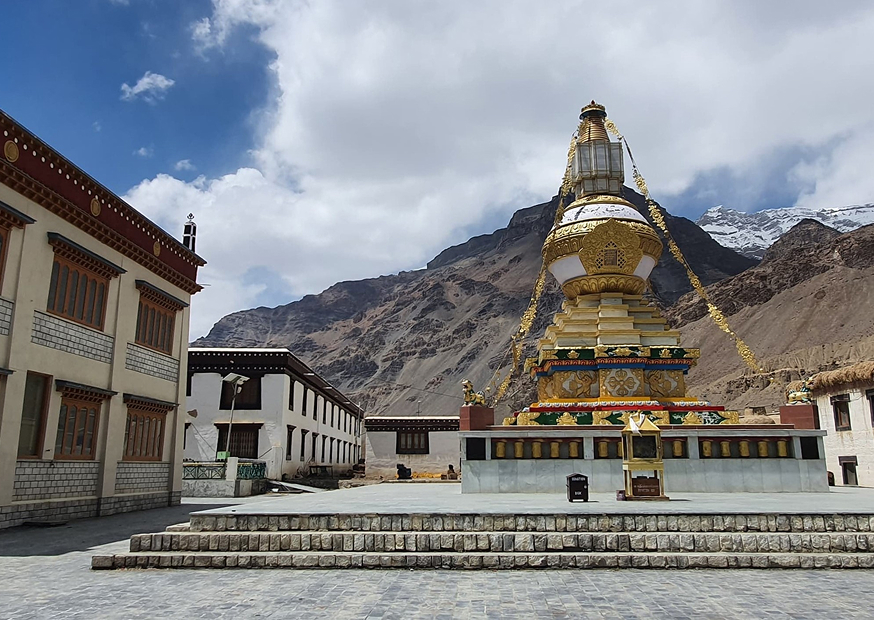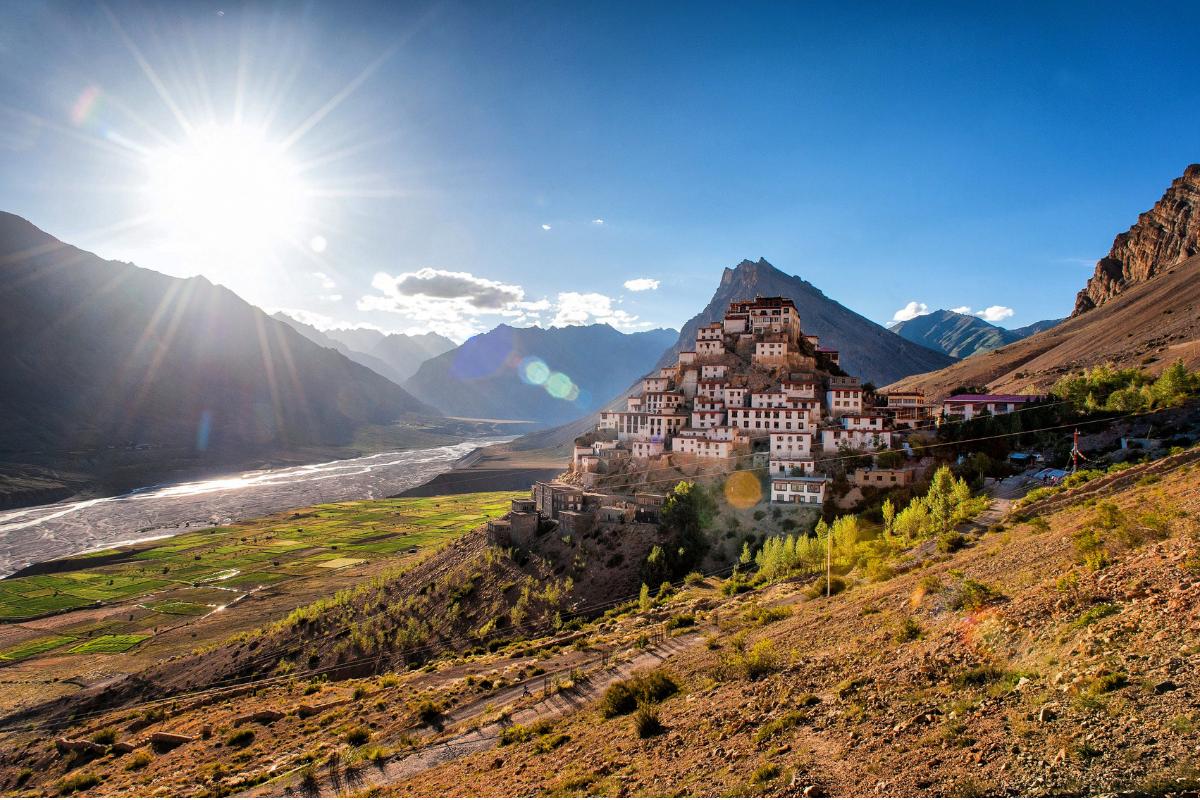Tabo Monastery: The Ajanta of the Himalayas
Nestled in the serene Spiti Valley of Himachal Pradesh, Tabo Monastery is an ancient Buddhist site renowned for its spiritual, historical, and artistic significance. Founded in 996 AD by the revered Tibetan Buddhist Lotsawa Rinchen Zangpo, this monastery is often referred to as the “Ajanta of the Himalayas” due to its intricate frescoes and stucco sculptures. Situated at an altitude of 3,280 meters (10,760 feet) above sea level, the monastery stands as a beacon of Tibetan Buddhism, attracting monks, scholars, and travelers from across the world.
History and Significance of Tabo Monastery
Tabo Monastery is considered one of the oldest continuously functioning Buddhist monasteries in the world. Established under the patronage of the Guge Kingdom, it has served as an essential center for Buddhist learning and meditation for over a millennium. Unlike other monasteries perched on hilltops, Tabo Monastery sits in a valley, symbolizing its accessibility to all seekers of wisdom.
The monastery belongs to the Gelugpa sect of Tibetan Buddhism but originally followed the Kadampa tradition before the Gelugpa school took prominence. It is also home to one of the oldest monastic complexes in India, making it a crucial site for historians, archaeologists, and spiritual practitioners alike.
Architectural Marvel of Tabo Monastery
The Main Temple Complex
The Tsuglagkhang (Main Temple) is the heart of Tabo Monastery. Its mud-brick walls, adorned with intricate murals and thangkas, preserve some of the finest specimens of Indo-Tibetan Buddhist art. The temple houses exquisite stucco sculptures of bodhisattvas, beautifully painted mandalas, and detailed depictions of the life of the Buddha.
The Nine Temples of Tabo
The Tabo monastery complex consists of nine temples, each with a distinct architectural and artistic style:
- The Assembly Hall (Du-kang) – A grand hall where monks gather for prayer and rituals.
- The Bodhisattva Maitreya Temple – Dedicated to the future Buddha, Maitreya.
- The Golden Temple (Serkhang) – Once covered in gold, this temple reflects the grandeur of Buddhist art.
- The Temple of Dromton – Named after the famous Buddhist master Dromton, known for his contributions to Tibetan Buddhism.
- The Mahakala Vajra Bhairava Temple – Dedicated to the fierce protective deity Mahakala.
- The White Temple (Kar-ldan Lakhang) – Known for its pristine appearance and ancient murals.
- The Temple of Enlightened Gods (Byams-Pa Lakhang) – Home to several depictions of enlightened deities.
- The Large Temple of Dromton (Dromton Lakhang Chenpo) – An expansive structure with exquisite frescoes.
- The Chamber of Picture Treasures (Z’al-ma) – Houses some of the monastery’s most significant paintings and artworks.
Cave Meditation Cells
Above the monastery, in the rugged cliffs, are numerous caves used by monks for meditation and retreat. These caves, carved into the mountains, have been an integral part of the monastery since its inception and serve as sites of deep contemplation and spiritual practice.
The Rich Artwork and Murals of Tabo Monastery
The murals and frescoes of Tabo Monastery are among its most prized treasures. These paintings, which cover the inner walls of the temples, depict Buddhist deities, mandalas, Jataka tales, and intricate symbols of Tantric Buddhism. The paintings are influenced by the Ajanta caves, with vivid colors and detailed expressions that bring the narratives to life.
The monastery also features wooden sculptures, stucco figures, and ancient manuscripts, making it an unparalleled repository of Buddhist art and culture. Due to the fragility of the artwork, preservation efforts are continuously undertaken to protect these invaluable relics from environmental wear and time-induced deterioration.
Festivals and Spiritual Significance
Tabo Monastery hosts several important Buddhist festivals and rituals throughout the year. One of the most celebrated events is the Kalachakra Initiation, a sacred Buddhist practice introduced by the 14th Dalai Lama, which draws thousands of devotees from across the globe. Other significant occasions include:
- Chakar Festival – A celebration involving sacred dances, chants, and prayers.
- Buddha Purnima – The birth anniversary of Lord Buddha, marked with grand processions and prayers.
- Losar Festival – The Tibetan New Year, featuring traditional music, dance, and offerings.
How to Reach Tabo Monastery
By Air
The nearest airport is Bhuntar Airport (Kullu-Manali Airport), approximately 250 km from Tabo. However, the best option is Chandigarh Airport, which offers better connectivity.
By Road
Tabo is well connected by road via the Shimla-Kaza Highway. The journey involves crossing high-altitude passes such as Kunzum Pass and Rohtang Pass. The nearest major town is Reckong Peo, from where regular buses and taxis are available.
By Train
The closest railway station is in Shimla, from where travelers can continue by road to reach Tabo via Reckong Peo and Kaza.
Best Time to Visit Tabo Monastery
The ideal time to visit Tabo Monastery is from May to October, when the weather is pleasant and the roads remain accessible. During winters, heavy snowfall makes travel challenging, but the monastery in its snow-covered glory is a breathtaking sight for those who can endure the harsh conditions.
Accommodation Options Near Tabo Monastery
Tabo offers a range of guesthouses, homestays, and monastery lodges for travelers. The monastery itself provides basic accommodation for visitors seeking an immersive spiritual experience. Some popular options include:
- Tabo Monastery Guesthouse – Run by the monastery, offering a peaceful ambiance.
- Maitreya Guesthouse – Known for its warm hospitality and comfortable stay.
- Sakya Abode – A cozy retreat for travelers exploring Spiti Valley.
Conclusion
Also Read: Kaza – The Heart of Spiti
Tabo Monastery is not just a religious site but a living testament to the rich heritage of Tibetan Buddhism. Its historical significance, architectural grandeur, and spiritual aura make it a must-visit destination for those seeking peace, knowledge, and artistic inspiration. Whether you are a devout Buddhist, a history enthusiast, or an avid traveler, Tabo Monastery promises an unforgettable journey into the heart of Himalayan spirituality and culture.






